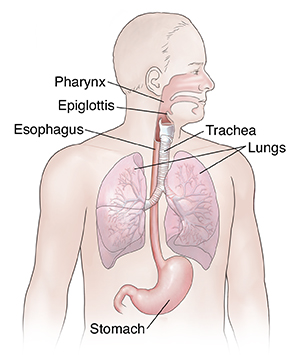Understanding Fiberoptic Evaluation of Swallowing (FEES)
Understanding Fiberoptic Evaluation of Swallowing (FEES)

Dysphagia and aspiration
When you swallow food, it passes from your mouth down into your throat (pharynx). From there, the food moves down through a long tube (esophagus) and into your stomach. This journey is made possible by a series of actions from the muscles in these areas. If you have dysphagia, the muscles don’t work properly. You may not be able to swallow normally.
The pharynx is also part of the system that brings air into your lungs. When you breathe, air enters your mouth and moves into the pharynx. The air then goes down into your main airway (trachea) and into your lungs. A flap of tissue called the epiglottis sits over the top of the trachea. This flap blocks food and drink from going down into the trachea when you swallow. Aspiration is when something enters the airway or lungs by accident. It may be food, liquid, or some other material. This can cause serious health problems, such as pneumonia. Aspiration can happen when a person has dysphagia.
Why a FEES test is done
A FEES test can help find out if you are having problems with any part of the swallowing process. An SLP will often first see how well you are swallowing with other simple tests. A FEES test is then done to get more information about your swallowing. If you have dysphagia, aspiration is always a risk. So dysphagia needs to be identified quickly. Many health problems can lead to dysphagia. Some examples are:
Stroke
Head or neck cancer
Head injury
Major dental problems
Conditions that lessen saliva (such as Sjogren’s syndrome)
Mouth sores
Parkinson’s disease or other neurologic conditions
Muscular dystrophies
Blockage in the esophagus (such as from cancer)
You may need a FEES test if you have symptoms such as:
Food sticking in your throat
Difficulty or pain while swallowing
Certain breathing problems
You may need the test even if you don’t have any symptoms of dysphagia. You may still be at risk for aspiration.
How a FEES test is done
An anesthetic will be sprayed in your nose and throat. This is so you don’t feel the endoscope. The SLP quickly puts the endoscope through your nose and down into your throat (pharynx). The endoscope sits above your epiglottis for most of the viewing. It then can be moved down after each swallow so the vocal folds may be seen. The endoscope allows your SLP to see parts of your larynx, pharynx, and trachea on a video screen. The endoscope may puff small amounts of air into your throat. This is to test the nerves in your throat. You may swallow small amounts of food or liquid during the test. These will be dyed so they can be seen on the screen.
Risks of a FEES test
All procedures have some risks. The SLP will work to lessen these risks. The risks of a FEES test include:
Nosebleed
Discomfort
Gagging or vomiting
Brief closing of your airway (laryngospasm)
A small amount of aspiration
Updated:
May 21, 2017
Reviewed By:
Dozier, Tennille, RN, BSN, RDMS,Image reviewed by StayWell medical illustration team.,Kacker, Ashutosh, MD